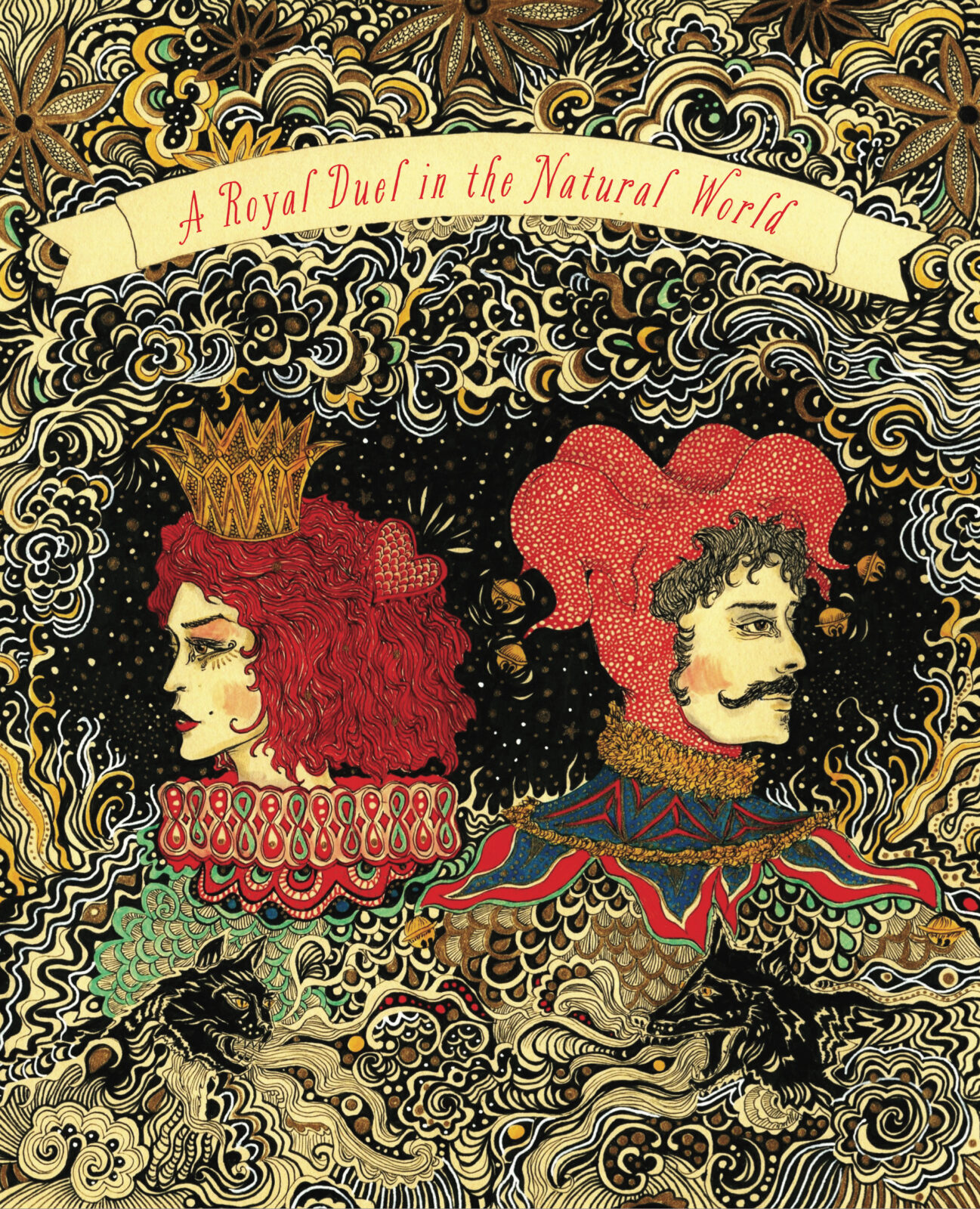
Illustration by Daria Hlazatova

Illustration by Daria Hlazatova
—Now, here, you see, it takes all the running you can do, to keep in the same place.
The Red Queen in Lewis Carroll’s Through the Looking-Glass, and What Alice Found There (1871)
In 1973 the evolutionary biologist Leigh Van Valen quoted Lewis Carroll’s Red Queen as a metaphor to explain what he viewed as the main driver of the diversification and extinction of species: the struggle of life itself. The Red Queen hypothesis argues that species must constantly adapt—or “run” in the queen’s words—as a survival mechanism. The constant competition for resources is what keeps us running. When one species becomes better at acquiring resources, the other species must adapt to keep up—”to keep in the same place.” This cancels out the long-term advantage of the adaptation in a single species.
The Red Queen hypothesis relies on the understanding that biotic interactions—those related to living things—underlie the evolution and extinction of species. Although Red Queen dynamics seem to be mostly limited to short timescales (less than one hundred thousand years), there are examples attesting to the role of biotic forces as an evolutionary driver over long timescales.
Take the diversification of canids—the dog family—in North America. The fossil record shows that in more than twenty million years of competitive interactions, dogs of the subfamily Borophaginae (bone-crushing dogs) gradually increased body mass and adopted a more carnivorous diet. This enabled them to compete with the hypercarnivorous, bigger dogs of the subfamily Hesperocyoninae (so-called Western dogs). Eventually bone-crushing dogs reached the same levels of meat eating as Western dogs and surpassed their body masses. The changes in the bone-crushing dogs’ feeding strategy and bodies coincided in time with a higher extinction rate in Western dogs. This suggests that the higher ecological similarity between the two groups of dogs created stronger competition.
A later migration of felids—the cat family—from Eurasia intensified the resource competition among the groups of canids, limiting the diversification of Western dogs and decimating its population. Western dogs faced extinction soon after, but bone-crushing dogs kept running. Competition with a third group of canids, Caninae (the subfamily that includes modern-day dogs), and the newly arrived cats continued. Bone-crushing dogs could not keep up with the pace of the resource competition, and ten million years later they became extinct.
Paleontologist Anthony Barnosky developed the Court Jester hypotheses to counterpoint the Red Queen model. In the Red Queen hypothesis, intrinsic traits pertaining to or originating from inside an organism or cell are the major drivers of biodiversity. According to the Court Jester theory, extrinsic abiotic factors—things related to the physical environment, like climate change, tectonics, or extraterrestrial impacts—play a more important role in shaping the diversity of life.
Court Jester hypotheses imply that shifts in the physical environment can change the rules imposed by biotic interactions. Thus an important difference between the Red Queen and Court Jester models of evolution is the timescale in which they seem to happen. Court Jester processes are known to prevail at longer timescales than the Red Queen dynamic, at over one hundred thousand years.
Most of the fossil record captures the timescale at which Court Jester processes operate, and it attests that changes in the richness, composition, and replacement of species over time occurred in relative synchrony with tectonic and climatic processes. We can see, for instance, the role of Earth’s geographic and tectonic history in driving patterns of species diversity in the distinctive terrestrial fauna and flora of South America. This continent remained isolated from other land masses for more than fifty million years, then experienced dramatic ecological changes after the uplift of the Isthmus of Panama, which connected North and South America.
The meteorite impact at the end of the Cretaceous period is a classic example of a Court Jester process. It changed the course of life on our planet, causing dinosaur extinction and the start of the mammal era. Climate change can also influence the geographic range of a species by limiting the type of resources available, increasing or reducing the diversity of environments, or causing a restructuring of the ecosystem when certain species disappear.
Depending on the timescale we use to view history, the evolution of the diversity of life comes down to interactions among living things (Red Queen) or physical factors (Court Jester). As the fossil record shows, the changes governing the evolution of life can accumulate gradually or appear suddenly, in a process characterized by long periods of stasis followed by rapid intervals of transformation. The survival of a species involves adapting to both new environmental conditions and new interactions with other species.
Regardless of how change happens, impermanence is the rule over all timescales. On a universal and evolutionary scale, change is the only constant. It is how the diversity of life is built and the only way for species to survive.
Barnosky, A. D. “Distinguishing the Effects of the Red Queen and Court Jester on Miocene Mammal Evolution in the Northern Rocky Mountains.” Journal of Vertebrate Paleontology 21, no. 1 (2001): 172–85.
Benton, M. J. “The Red Queen and the Court Jester: Species Diversity and the Role of Biotic and Abiotic Factors through Time.” Science 323, no. 5915 (2009): 728–32.
Silvestro, D., Antonelli, A., Salamin, N., and Quental, T. B. “The Role of Clade Competition in the Diversification of North American Canids.” Proceedings of the National Academy of Sciences 112, no. 28 (2015): 8684–89.
Van Valen, L. “A New Evolutionary Law.” Evolutionary Theory 1 (1973): 1–30.

Julia Tejada is a paleontologist who uses the chemical composition of fossils and modern bones to understand how ecosystems change through time, as well as how animals partition their resources within an ecosystem. Julia received her PhD from Columbia University and the American Museum of Natural History. She has published scientific articles widely and has led expeditions in the Andean Plateau, coastal deserts of Peru, and western Amazonia. She is the first female vertebrate paleontologist in Peru, her country of origin.
Get the latest news and stories from the Rubin, plus occasional information on how to support our work.